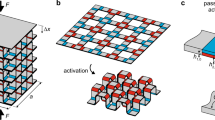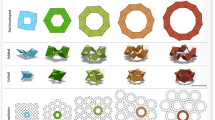Abstract
Mechanical instabilities that cause periodic wrinkling during compression of layered materials find applications in stretchable electronics1,2,3 and microfabrication4,5,6,7, but can also limit an application’s performance owing to delamination or cracking under loading8 and surface inhomogeneities during swelling9. In particular, because of curvature localization, finite deformations can cause wrinkles to evolve into folds. The wrinkle-to-fold transition has been documented in several systems, mostly under uniaxial stress10,11,12,13. However, the nucleation, the spatial structure and the dynamics of the invasion of folds in two-dimensional stress configurations remain elusive. Here, using a two-layer polymeric system under biaxial compressive stress, we show that a repetitive wrinkle-to-fold transition generates a hierarchical network of folds during reorganization of the stress field. The folds delineate individual domains, and each domain subdivides into smaller ones over multiple generations. By modifying the boundary conditions and geometry, we demonstrate control over the final network morphology. The ideas introduced here should find application in the many situations where stress impacts two-dimensional pattern formation.
This is a preview of subscription content, access via your institution
Access options
Subscribe to this journal
Receive 12 print issues and online access
$259.00 per year
only $21.58 per issue
Buy this article
- Purchase on Springer Link
- Instant access to full article PDF
Prices may be subject to local taxes which are calculated during checkout





Similar content being viewed by others
References
Rogers, J. A., Someya, T. & Huang, Y. G. Materials and mechanics for stretchable electronics. Science 327, 1603–1607 (2010).
Kim, R. H. et al. Waterproof AlInGaP optoelectronics on stretchable substrates with applications in biomedicine and robotics. Nature Mater. 9, 929–937 (2010).
Hamers, R. J. Flexible electronic futures. Nature 412, 489–490 (2001).
Koo, W. H. et al. Light extraction from organic light-emitting diodes enhanced by spontaneously formed buckles. Nature Photon. 4, 222–226 (2010).
Efimenko, K. et al. Nested self-similar wrinkling patterns in skins. Nature Mater. 4, 293–297 (2005).
Stafford, C. M. et al. A buckling-based metrology for measuring the elastic moduli of polymeric thin films. Nature Mater. 3, 545–550 (2004).
Bowden, N., Brittain, S, Evans, A. G., Hutchinson, J. W. & Whitesides, G. M. Spontaneous formation of ordered structures in thin films of metals supported on an elastomeric polymer. Nature 393, 146–149 (1998).
Kim, D. H. et al. Stretchable and foldable silicon integrated circuits. Science 320, 507–511 (2008).
Tanaka, T. et al. Mechanical instability of gels at the phase-transition. Nature 325, 796–798 (1987).
Leahy, B. D. et al. Geometric stability and elastic response of a supported nanoparticle film. Phys. Rev. Lett. 105, 058301 (2010).
Brau, F. et al. Multiple-length-scale elastic instability mimics parametric resonance of nonlinear oscillators. Nature Phys. 7, 56–60 (2010).
Reis, P. M., Corson, F., Boudaoud, A. & Roman, B. Localization through surface folding in solid foams under compression. Phys. Rev. Lett. 103, 045501 (2009).
Pocivavsek, L. et al. Stress and fold localization in thin elastic membranes. Science 320, 912–916 (2008).
Biot, M. A. Folding instability of a layered viscoelastic medium under compression. Proc. R. Soc. Lond. Ser. A 242, 444–454 (1957).
Huang, R. & Im, S. H. Dynamics of wrinkle growth and coarsening in stressed thin films. Phys. Rev. E 74, 026214 (2006).
Edmondson, S., Frieda, K., Comrie, J. E., Onck, P. R. & Huck, W. T. S. Buckling in quasi-2D polymers. Adv. Mater. 18, 724–728 (2006).
Chen, X. & Hutchinson, J. W. Herringbone buckling patterns of compressed thin films on compliant substrates. J. Appl. Mech.-T Asme 71, 597–603 (2004).
Yin, H. Z. et al. Buckling suppression of SiGe islands on compliant substrates. J. Appl. Phys. 94, 6875–6882 (2003).
Price, N. J. & Cosgrove, J. W. Analysis of Geological Structures (Cambridge Univ. Press, 1990).
Zartman, J. J. & Shvartsman, S. Y. Unit operations of tissue development: Epithelial folding. Annu. Rev. Chem. Biomol. 1, 231–246 (2010).
Holmes, D. P. & Crosby, A. J. Draping flms: A wrinkle to fold transition. Phys. Rev. Lett. 105, 038303 (2010).
Kim, J., Yoon, J. & Hayward, R. C. Dynamic display of biomolecular patterns through an elastic creasing instability of stimuli-responsive hydrogels. Nature Mater. 9, 159–164 (2010).
Hohlfeld, E. & Mahadevan, L. Unfolding the sulcus. Phys. Rev. Lett. 106, 105702 (2011).
Huang, Z. Y., Hong, W. & Suo, Z. Nonlinear analyses of wrinkles in a film bonded to a compliant substrate. J. Mech. Phys. Solids 53, 2101–2118 (2005).
Shorlin, K. A., de Bruyn, J. R., Graham, M. & Morris, S. W. Development and geometry of isotropic and directional shrinkage-crack patterns. Phys. Rev. E 61, 6950–6957 (2000).
Bohn, S., Pauchard, L. & Couder, Y. Hierarchical crack pattern as formed by successive domain divisions. I. Temporal and geometrical hierarchy. Phys. Rev. E 71, 046214 (2005).
Skjeltorp, A. T. & Meakin, P. Fracture in microsphere monolayers studied by experiment and computer-simulation. Nature 335, 424–426 (1988).
Couder, Y., Pauchard, L., Allain, C., Adda-Bedia, M. & Douady, S. The leaf venation as formed in a tensorial field. Eur. Phys. J. B 28, 135–138 (2002).
Corson, F., Henry, H. & Adda-Bedia, M. A model for hierarchical patterns under mechanical stresses. Phil. Mag. 90, 357–373 (2010).
Kranz, R. L. Crack–crack and crack–pore interactions in stressed granite. Int. J. Rock Mech. Min. 16, 37–47 (1979).
Kim, P., Jeong, H. E., Khademhosseini, A. & Suh, K. Y. Fabrication of non-biofouling polyethylene glycol micro- and nanochannels by ultraviolet-assisted irreversible sealing. Lab. Chip 6, 1432–1437 (2006).
Pizzi, A. & Mittal, K. L. Handbook of Adhesive Technology 2nd edn (M. Dekker, 2003).
van Dillen, T., Polman, A., van Kats, C. M. & van Blaaderen, A. Ion beam-induced anisotropic plastic deformation at 300 keV. Appl. Phys. Lett. 83, 4315–4317 (2003).
Acknowledgements
This work was supported by the Multidisciplinary University Research Initiative (MURI) program project funded through the Army Research Office, the National Research Foundation of Korea Grant (NRF-2009-352-D00034) and the Centre National de la Recherche Scientifique. M.A. is particularly grateful for the support offered by H.A.S. during his stay.
Author information
Authors and Affiliations
Contributions
P.K., M.A. and H.A.S. designed the concepts. P.K. and M.A. carried out the experiments. P.K., M.A. and H.A.S. discussed and interpreted results. P.K., M.A. and H.A.S. wrote the paper.
Corresponding author
Ethics declarations
Competing interests
The authors declare no competing financial interests.
Supplementary information
Supplementary Information
Supplementary Information (PDF 1298 kb)
Supplementary Information
Supplementary Movie (AVI 8116 kb)
Supplementary Information
Supplementary Movie (AVI 11696 kb)
Supplementary Information
Supplementary Movie (AVI 397 kb)
Supplementary Information
Supplementary Movie (AVI 4155 kb)
Supplementary Information
Supplementary Movie (AVI 47633 kb)
Rights and permissions
About this article
Cite this article
Kim, P., Abkarian, M. & Stone, H. Hierarchical folding of elastic membranes under biaxial compressive stress. Nature Mater 10, 952–957 (2011). https://doi.org/10.1038/nmat3144
Received:
Accepted:
Published:
Issue Date:
DOI: https://doi.org/10.1038/nmat3144
This article is cited by
-
Bioinspired Multiscale Wrinkling Patterns on Curved Substrates: An Overview
Nano-Micro Letters (2020)
-
Tailor-made nanostructures bridging chaos and order for highly efficient white organic light-emitting diodes
Nature Communications (2019)
-
A skin-over-liquid platform with compliant microbumps actuated by pyro-EHD pressure
NPG Asia Materials (2019)
-
Fabrication of Grid-Type Transparent Conducting Electrodes Based on Controlled Mechanical Fracture
Macromolecular Research (2018)
-
Buckling analysis in stretchable electronics
npj Flexible Electronics (2017)



